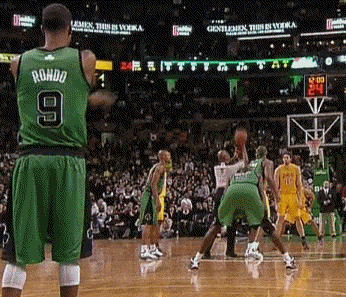Basketball players, especially at higher levels are known for high flying dunks and alley-oops. Players can pass to themselves in certain scenarios.
Basketball players can not pass to themselves. The ball needs to first touch the backboard, basket ring, or another player. If the player passes to himself it will result in a turnover.
In this article we’re going to show you the rules of passing to yourself and how to avoid a turnover.
The Rules On Self Pass
The NBA rules state:
A player may not be the first to touch his own pass unless the ball touches his back- board, basket ring or another player. Upon ending his dribble or gaining control of the ball, a player may not touch the floor consecutively with the same foot (hop).
In other words, a player is not able to throw the ball down the court several times to themselves, as it will result in a travel.
There are some exceptions to the rule, which may seem like a travel during a game, but is hardly ever called.
Self Pass Traveling
Just so we get a clear understanding of a travel, let’s first learn how the NBA defines traveling, that way we don’t commit the foul and turn the ball over during a crucial part of the game.
The NBA defines traveling as:
- A player shall not run with the ball without dribbling it.
- A player in control of a dribble who steps on or outside a boundary line, even though not touching the ball while on or outside that boundary line, shall not be allowed to return in-bounds and continue his dribble. He may not even be the first player to touch the ball after he has re-established a position in-bounds.
- A player may not dribble a second time after he has voluntarily ended his first dribble.
- A player who is dribbling may not put any part of his hand under the ball and (1) carry it from one point to another or (2) bring it to a pause and then continue to dribble again.
- A player may dribble a second time if he lost control of the ball because of:
- A field goal attempt at his basket, provided the ball touches the backboard or basket ring
- An opponent touching the ball
- A pass or fumble which touches his backboard, basket ring or is touched by another player.
- PENALTY: Loss of ball. Ball is awarded to the opposing team on the sideline nearest the spot of the violation but no nearer the baseline than the foul line extended.
Now that we’ve established what traveling is and how it’s committed, let’s learn more about the self pass and what is legal and what’s not.
Self Pass In Transition
It may seem like a player is self passing when they are in transition. For example, if the ball is stolen from an offensive player, we’ll see a the defender get the ball, throw the ball forward to themselves and continue to lay the ball in.
This is perfectly legal because the player who receives the basketball the possession of the ball is never officially established with his hands and/or feet. The player is in transition and will establish the ball on his next dribble.
At The Beginning Of The Game Or An Inbound Pass

At the beginning of the game, off the tip-off, players can often be seen getting the ball, fixing their shorts or even headband as they walk next to the basketball, and continuing to press the ball up court.
This can be seen as a “self pass” as the player has taken multiple steps without the basketball, as it rolls up court. This foul will almost never be called, as the referees, offense and defense are getting into place.
Players in the NBA such as Rajon Rondo can almost always been seen doing some sort of self pass as they receive the opening tipoff.
Self Pass Off The Backboard
One of the more exciting plays in the NBA is when a player bounces it off the back board and slams it through the rim.
Passing it off the backboard is completely legal. The reason it’s legal a pass toward the backboard or rim is considered a shot. The referee has no judgement if the player is trying to score or trying to pass the back to themselves.
By rule the referee must treat the act of throwing the ball off the backboard, toward the rim, as a shot. Players are able to bounce the ball off the backboard to themselves or to their teammates off an alley-oop.
There is a small tinker in the rule. If the player puts it up off the backboard and it doesn’t hit rim, the player may not come back down with the basketball, as it will be called a travel. Once the ball hits the backboard, the player must attempt to shoot the ball or pass it. They must not come down clean with the ball.
Inbound Self Pass
Players are not permitted to inbound themselves the basketball. This is why we often see players bounce the ball off the back of other players in order to get the ball back themselves. Here is a visual of what we mean:
In order to touch the ball off of an inbound play, a player of the same team or the opposing team must touch the ball first, before the player inbounding touches it.
This will be called a travel if the player who’s inbounding the ball touches it before any other player does.
Conclusion
It’s important to study the travel rules that are listed above. Having a complete understanding of when to dribble and when it’s OK not to dribble can have a dramatic impact in a game. In basketball, every possession counts as games are often won with as few as 1 or 2 points.
A player can not pass to themselves off an inbound pass, as they need another player to touch the ball first.
However if it is off the tip-off, a pass from another player, stealing the ball or off the back board, the player may move continuously without the ball in their hands until they maintain possession.
